
Rose window
Encyclopedia

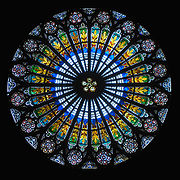
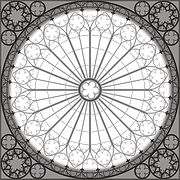
Window
A window is a transparent or translucent opening in a wall or door that allows the passage of light and, if not closed or sealed, air and sound. Windows are usually glazed or covered in some other transparent or translucent material like float glass. Windows are held in place by frames, which...
, but is especially used for those found in churches of the Gothic architectural style
Gothic architecture
Gothic architecture is a style of architecture that flourished during the high and late medieval period. It evolved from Romanesque architecture and was succeeded by Renaissance architecture....
and being divided into segments by stone mullion
Mullion
A mullion is a vertical structural element which divides adjacent window units. The primary purpose of the mullion is as a structural support to an arch or lintel above the window opening. Its secondary purpose may be as a rigid support to the glazing of the window...
s and tracery
Tracery
In architecture, Tracery is the stonework elements that support the glass in a Gothic window. The term probably derives from the 'tracing floors' on which the complex patterns of late Gothic windows were laid out.-Plate tracery:...
. The name “rose window” was not used before the 17th century and according to the Oxford English Dictionary, among other authorities, comes from the English flower name rose
Rose
A rose is a woody perennial of the genus Rosa, within the family Rosaceae. There are over 100 species. They form a group of erect shrubs, and climbing or trailing plants, with stems that are often armed with sharp prickles. Flowers are large and showy, in colours ranging from white through yellows...
.
The term “wheel window” is often applied to a window divided by simple spokes radiating from a central boss or opening, while the term “rose window” is reserved for those windows, sometimes of a highly complex design, which can be seen to bear similarity to a multi-petalled rose. Rose windows are also called Catherine windows after Saint Catherine of Alexandria who was sentenced to be executed on a spiked wheel. A circular window without tracery, such as are found in many Italian churches, is referred to as an ocular window or oculus
Oculus
An Oculus, circular window, or rain-hole is a feature of Classical architecture since the 16th century. They are often denoted by their French name, oeil de boeuf, or "bull's-eye". Such circular or oval windows express the presence of a mezzanine on a building's façade without competing for...
.
Rose windows are particularly characteristic of Gothic architecture
Gothic architecture
Gothic architecture is a style of architecture that flourished during the high and late medieval period. It evolved from Romanesque architecture and was succeeded by Renaissance architecture....
and may be seen in all the major Gothic Cathedrals of Northern France
France
The French Republic , The French Republic , The French Republic , (commonly known as France , is a unitary semi-presidential republic in Western Europe with several overseas territories and islands located on other continents and in the Indian, Pacific, and Atlantic oceans. Metropolitan France...
. Their origins are much earlier and rose windows may be seen in various forms throughout the Medieval period. Their popularity was revived, with other medieval features, during the Gothic revival
Gothic Revival architecture
The Gothic Revival is an architectural movement that began in the 1740s in England...
of the 19th century so that they are seen in Christian churches all over the world.
History

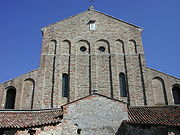
Origin
The origin of the rose window may be found in the RomanRoman architecture
Ancient Roman architecture adopted certain aspects of Ancient Greek architecture, creating a new architectural style. The Romans were indebted to their Etruscan neighbors and forefathers who supplied them with a wealth of knowledge essential for future architectural solutions, such as hydraulics...
oculus
Oculus
An Oculus, circular window, or rain-hole is a feature of Classical architecture since the 16th century. They are often denoted by their French name, oeil de boeuf, or "bull's-eye". Such circular or oval windows express the presence of a mezzanine on a building's façade without competing for...
. These large circular openings let in both light and air, the best known being that at the top of the dome of the Pantheon
Pantheon, Rome
The Pantheon ,Rarely Pantheum. This appears in Pliny's Natural History in describing this edifice: Agrippae Pantheum decoravit Diogenes Atheniensis; in columnis templi eius Caryatides probantur inter pauca operum, sicut in fastigio posita signa, sed propter altitudinem loci minus celebrata.from ,...
.
In Early Christian and Byzantine architecture
Byzantine architecture
Byzantine architecture is the architecture of the Byzantine Empire. The empire gradually emerged as a distinct artistic and cultural entity from what is today referred to as the Roman Empire after AD 330, when the Roman Emperor Constantine moved the capital of the Roman Empire east from Rome to...
, there are examples of the use of circular oculi. They usually occur either around the drum of a dome, as at the Church of the Holy Sepulchre
Church of the Holy Sepulchre
The Church of the Holy Sepulchre, also called the Church of the Resurrection by Eastern Christians, is a church within the walled Old City of Jerusalem. It is a few steps away from the Muristan....
, Jerusalem, or high in the end of a gable of low-pitched Classical pediment
Pediment
A pediment is a classical architectural element consisting of the triangular section found above the horizontal structure , typically supported by columns. The gable end of the pediment is surrounded by the cornice moulding...
form, as at Sant'Agnese fuori le mura
Sant'Agnese fuori le mura
The church of Saint Agnes Outside the Wall is a titulus church, minor basilica in Rome, on a site sloping down from the Via Nomentana, which runs north-east out of the city, still under its ancient name. What is said to be the remains of Saint Agnes's are below the high altar...
, Rome
Rome
Rome is the capital of Italy and the country's largest and most populated city and comune, with over 2.7 million residents in . The city is located in the central-western portion of the Italian Peninsula, on the Tiber River within the Lazio region of Italy.Rome's history spans two and a half...
, and Torcello Cathedral.
A window of the 8th century, now located in Venice
Venice
Venice is a city in northern Italy which is renowned for the beauty of its setting, its architecture and its artworks. It is the capital of the Veneto region...
, and carved from a single slab, has alternating tracery-like components of two tiers of four lancets separated by three oculi. Many semicircular windows with pierced tracery exist from the sixth to 8th century, and later in Greece
Greece
Greece , officially the Hellenic Republic , and historically Hellas or the Republic of Greece in English, is a country in southeastern Europe....
.
Small circular windows such as that at S. Agnese and Torcello as well as unglazed decorative circular recesses continued to be used in churches in Italy, gaining increasing popularity in the later Romanesque period
Romanesque architecture
Romanesque architecture is an architectural style of Medieval Europe characterised by semi-circular arches. There is no consensus for the beginning date of the Romanesque architecture, with proposals ranging from the 6th to the 10th century. It developed in the 12th century into the Gothic style,...
.
The German art historian Otto von Simson considered that the origin of the rose window lay in a window with the six-lobed rosettes and octagon which adorned the external wall of the Umayyad
Umayyad
The Umayyad Caliphate was the second of the four major Arab caliphates established after the death of Muhammad. It was ruled by the Umayyad dynasty, whose name derives from Umayya ibn Abd Shams, the great-grandfather of the first Umayyad caliph. Although the Umayyad family originally came from the...
palace Khirbat al-Mafjar built in Jordan between 740 and 750 CE. This theory suggests that crusaders
Crusaders
The Crusaders are a New Zealand professional rugby union team based in Christchurch that competes in the Super Rugby competition. They are the most successful team in Super Rugby history with seven titles...
brought the design of this attractive window to Europe, introducing it to churches.

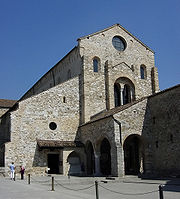
The windows of Oviedo
In the vicinity of OviedoOviedo
Oviedo is the capital city of the Principality of Asturias in northern Spain. It is also the name of the municipality that contains the city....
in Spain
Spain
Spain , officially the Kingdom of Spain languages]] under the European Charter for Regional or Minority Languages. In each of these, Spain's official name is as follows:;;;;;;), is a country and member state of the European Union located in southwestern Europe on the Iberian Peninsula...
are several churches of the late 9th and early 10th century which display a remarkable array of windows containing the earliest examples of tracery outside the Byzantine Empire
Byzantine Empire
The Byzantine Empire was the Eastern Roman Empire during the periods of Late Antiquity and the Middle Ages, centred on the capital of Constantinople. Known simply as the Roman Empire or Romania to its inhabitants and neighbours, the Empire was the direct continuation of the Ancient Roman State...
. The designs closely resemble the motifs found on the Byzantine relief carvings of marble sarcophagi
Sarcophagus
A sarcophagus is a funeral receptacle for a corpse, most commonly carved or cut from stone. The word "sarcophagus" comes from the Greek σαρξ sarx meaning "flesh", and φαγειν phagein meaning "to eat", hence sarkophagus means "flesh-eating"; from the phrase lithos sarkophagos...
, pulpit
Pulpit
Pulpit is a speakers' stand in a church. In many Christian churches, there are two speakers' stands at the front of the church. Typically, the one on the left is called the pulpit...
s and well heads and pierced decorations of screens and windows of Ravenna
Ravenna
Ravenna is the capital city of the Province of Ravenna in the Emilia-Romagna region of Italy and the second largest comune in Italy by land area, although, at , it is little more than half the size of the largest comune, Rome...
and Constantinople
Constantinople
Constantinople was the capital of the Roman, Eastern Roman, Byzantine, Latin, and Ottoman Empires. Throughout most of the Middle Ages, Constantinople was Europe's largest and wealthiest city.-Names:...
. The church of San Pedro has a rectangular window with a pierced decoration of two overlapping circles, the upper containing a Greek Cross, the window being divided by the circles and the arms of the cross into numerous sections like tracery “lights”.
In another of these churches, San Miguel de Lillo
San Miguel de Lillo
-External links:* * http://www.360cities.net/business/san-miguel-de-lillo-oviedo-world-heritage* http://www.santamariadelnaranco.es/...
, is the earliest known example of an axially placed oculus with tracery. Several such windows of different sizes exist, and decoration of both Greek Cross and scalloped petal-like form occur, prefiguring both wheel and rose windows.
Romanesque circular windows
Circular windows and decorative circular recesses are a feature of many RomanesqueRomanesque architecture
Romanesque architecture is an architectural style of Medieval Europe characterised by semi-circular arches. There is no consensus for the beginning date of the Romanesque architecture, with proposals ranging from the 6th to the 10th century. It developed in the 12th century into the Gothic style,...
churches and cathedrals, particularly in Germany
Germany
Germany , officially the Federal Republic of Germany , is a federal parliamentary republic in Europe. The country consists of 16 states while the capital and largest city is Berlin. Germany covers an area of 357,021 km2 and has a largely temperate seasonal climate...
and Italy
Italy
Italy , officially the Italian Republic languages]] under the European Charter for Regional or Minority Languages. In each of these, Italy's official name is as follows:;;;;;;;;), is a unitary parliamentary republic in South-Central Europe. To the north it borders France, Switzerland, Austria and...
where the style existed for a prolonged period, overlapping the development of Gothic in France
France
The French Republic , The French Republic , The French Republic , (commonly known as France , is a unitary semi-presidential republic in Western Europe with several overseas territories and islands located on other continents and in the Indian, Pacific, and Atlantic oceans. Metropolitan France...
and its arrival with French architects in England.
In Germany, Worms Cathedral
Worms Cathedral
Cathedral of St Peter is a church in Worms, southern Germany. It was the seat of the Catholic Prince-Bishopric of Worms until its extinction in 1800.It is a basilica with four round towers, two large domes, and a choir at each end...
, has wheel windows in the pedimental ends of its nave and gables, very similar to the Early Christian Basilica
Basilica
The Latin word basilica , was originally used to describe a Roman public building, usually located in the forum of a Roman town. Public basilicas began to appear in Hellenistic cities in the 2nd century BC.The term was also applied to buildings used for religious purposes...
of S. Agnese in Rome. The apsidal western end has a central wheel window with smaller oculi in each face. The Church of the Apostles, Cologne
Cologne
Cologne is Germany's fourth-largest city , and is the largest city both in the Germany Federal State of North Rhine-Westphalia and within the Rhine-Ruhr Metropolitan Area, one of the major European metropolitan areas with more than ten million inhabitants.Cologne is located on both sides of the...
has an array of both ocular and lobed windows forming decorative features in the gables and beneath the Rhenish Helm spire
Spire
A spire is a tapering conical or pyramidal structure on the top of a building, particularly a church tower. Etymologically, the word is derived from the Old English word spir, meaning a sprout, shoot, or stalk of grass....
. The octagonal dome
Dome
A dome is a structural element of architecture that resembles the hollow upper half of a sphere. Dome structures made of various materials have a long architectural lineage extending into prehistory....
has a ring of oculi with two in each of the curved faces.
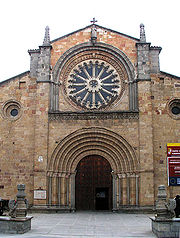
Trebíc
Třebíč is a city in the Moravian part of the Vysočina Region of the Czech Republic.Třebíč is situated 35 km southeast of Jihlava and 65 km west of Brno on the Jihlava River. Třebíč is from 392 to 503 metres above sea-level....
, Czech Republic
Czech Republic
The Czech Republic is a landlocked country in Central Europe. The country is bordered by Poland to the northeast, Slovakia to the east, Austria to the south, and Germany to the west and northwest....
, is the 12th- and 13th-century Romanesque style Basilica of St Procopius with apsidal windows similar to those at Worms, but in this case the openings are filled with tracery of a Gothic form, clearly marking the transition to a new style.
In Italy, the use of circular motifs in various media was a feature of church facades, occurring on Early Christian, Romanesque
Romanesque architecture
Romanesque architecture is an architectural style of Medieval Europe characterised by semi-circular arches. There is no consensus for the beginning date of the Romanesque architecture, with proposals ranging from the 6th to the 10th century. It developed in the 12th century into the Gothic style,...
, Gothic
Gothic architecture
Gothic architecture is a style of architecture that flourished during the high and late medieval period. It evolved from Romanesque architecture and was succeeded by Renaissance architecture....
, Renaissance
Renaissance architecture
Renaissance architecture is the architecture of the period between the early 15th and early 17th centuries in different regions of Europe, demonstrating a conscious revival and development of certain elements of ancient Greek and Roman thought and material culture. Stylistically, Renaissance...
and Baroque
Baroque architecture
Baroque architecture is a term used to describe the building style of the Baroque era, begun in late sixteenth century Italy, that took the Roman vocabulary of Renaissance architecture and used it in a new rhetorical and theatrical fashion, often to express the triumph of the Catholic Church and...
churches, a well-known example being those great circles in polychrome
Polychrome
Polychrome is one of the terms used to describe the use of multiple colors in one entity. It has also been defined as "The practice of decorating architectural elements, sculpture, etc., in a variety of colors." Polychromatic light is composed of a number of different wavelengths...
marble which complement the central circular window on Alberti’s
Alberti
-Places:* Alberti Partido, a partido of Buenos Aires Province, Argentina* Alberti, Buenos Aires, the main town of the partido-Other:*Alberti bass, a musical accompaniment figuration, usually in the left hand on a keyboard instrument...
Early Renaissance façade at Santa Maria Novella in Florence
Florence
Florence is the capital city of the Italian region of Tuscany and of the province of Florence. It is the most populous city in Tuscany, with approximately 370,000 inhabitants, expanding to over 1.5 million in the metropolitan area....
. Oculi were also typically used in the drums supporting domes and as upper lights in octagonal baptisteries such as that at Cremona
Cremona
Cremona is a city and comune in northern Italy, situated in Lombardy, on the left bank of the Po River in the middle of the Pianura Padana . It is the capital of the province of Cremona and the seat of the local City and Province governments...
.
Romanesque facades with oculi include San Miniato al Monte, Florence
Florence
Florence is the capital city of the Italian region of Tuscany and of the province of Florence. It is the most populous city in Tuscany, with approximately 370,000 inhabitants, expanding to over 1.5 million in the metropolitan area....
, 11th century, San Michele, Pavia
Pavia
Pavia , the ancient Ticinum, is a town and comune of south-western Lombardy, northern Italy, 35 km south of Milan on the lower Ticino river near its confluence with the Po. It is the capital of the province of Pavia. It has a population of c. 71,000...
, c. 1117, and Pistoia Cathedral
Pistoia
Pistoia is a city and comune in the Tuscany region of Italy, the capital of a province of the same name, located about 30 km west and north of Florence and is crossed by the Ombrone Pistoiese, a tributary of the River Arno.-History:...
, 1150. As the windows increased in size in the later Romanesque period, wheel windows became a standard feature of which there are fine examples at San Zeno Maggiore, Verona
Verona
Verona ; German Bern, Dietrichsbern or Welschbern) is a city in the Veneto, northern Italy, with approx. 265,000 inhabitants and one of the seven chef-lieus of the region. It is the second largest city municipality in the region and the third of North-Eastern Italy. The metropolitan area of Verona...
and Monza Cathedral
Monza
Monza is a city and comune on the river Lambro, a tributary of the Po, in the Lombardy region of Italy some 15 km north-northeast of Milan. It is the capital of the Province of Monza and Brianza. It is best known for its Grand Prix motor racing circuit, the Autodromo Nazionale Monza.On June...
.
On the Romanesque façade of Spoleto Cathedral
Spoleto
Spoleto is an ancient city in the Italian province of Perugia in east central Umbria on a foothill of the Apennines. It is S. of Trevi, N. of Terni, SE of Perugia; SE of Florence; and N of Rome.-History:...
there is a profusion of recessed and traceried oculi surrounding the central features of a rose window set within a square beneath a large mosaic of 1207.
In England there exist five Romanesque wheel windows, notably those at Barfreston and Castle Hedingham
Castle Hedingham
Castle Hedingham is a small village in northeast Essex, England, located four miles west of Halstead and is situated in the Colne Valley on the ancient road from Colchester, Essex, to Cambridge....
parish churches.
St Denis, Chartres, Mantes, Laon and Paris
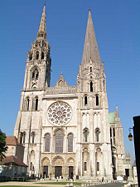
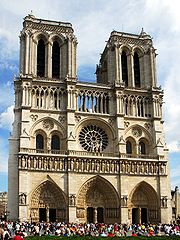
Saint Denis Basilica
The Cathedral Basilica of Saint Denis is a large medieval abbey church in the commune of Saint-Denis, now a northern suburb of Paris. The abbey church was created a cathedral in 1966 and is the seat of the Bishop of Saint-Denis, Pascal Michel Ghislain Delannoy...
, to the north of Paris
Paris
Paris is the capital and largest city in France, situated on the river Seine, in northern France, at the heart of the Île-de-France region...
, where the Abbot Suger
Abbot Suger
Suger was one of the last Frankish abbot-statesmen, an historian, and the influential first patron of Gothic architecture....
, between 1130 and 1144, gathered the various newly emerging features of Gothic into a single building, thereby “creating” the Gothic style
Gothic architecture
Gothic architecture is a style of architecture that flourished during the high and late medieval period. It evolved from Romanesque architecture and was succeeded by Renaissance architecture....
.
Suger’s original rose window in the prototype Gothic façade of St Denis probably pre-dates many of the remaining circular windows in Romanesque buildings such as those in England, at Trebic and Spoleto and that in the façade at Speyer.
Suger’s window was not distinctively Gothic in its appearance. It no longer has its original form, but a mid-19th-century drawing by the restorer Viollet-le-Duc
Eugène Viollet-le-Duc
Eugène Emmanuel Viollet-le-Duc was a French architect and theorist, famous for his interpretive "restorations" of medieval buildings. Born in Paris, he was a major Gothic Revival architect.-Early years:...
indicates that it had a very large ocular space at the centre, the glass supported by an iron hoop, and surrounded by simple semicircular cusped lobes cut out of flat stone in a technique known as "plate tracery". The window now has Gothic tracery in it, possibly added by Viollet-le-Duc
Eugène Viollet-le-Duc
Eugène Emmanuel Viollet-le-Duc was a French architect and theorist, famous for his interpretive "restorations" of medieval buildings. Born in Paris, he was a major Gothic Revival architect.-Early years:...
who was very concerned about the lack of stability of the whole façade, and having restored the towers, was impelled to demolish the northern one when it suddenly subsided.
Along with the simple wheel windows of the late Norman period
Norman architecture
About|Romanesque architecture, primarily English|other buildings in Normandy|Architecture of Normandy.File:Durham Cathedral. Nave by James Valentine c.1890.jpg|thumb|200px|The nave of Durham Cathedral demonstrates the characteristic round arched style, though use of shallow pointed arches above the...
in England, Germany and Italy, a large late 12th-century window still exists at Chartres Cathedral. This remarkable window combines a large roundel at the centre with the radiating spokes of a wheel window, surrounded by a ring of smaller “plate tracery” lights with scalloped borders. The window, depicting the Last Judgement, contains its original scheme of glazing and retains much of the original glass of 1215, despite suffering damage during World War II
World War II
World War II, or the Second World War , was a global conflict lasting from 1939 to 1945, involving most of the world's nations—including all of the great powers—eventually forming two opposing military alliances: the Allies and the Axis...
.
Following the west window of Chartres, more daring Gothic windows were created at the Collegiate Church of Notre-Dame in Mantes and in the dynamically sculptural facade of Laon Cathedral (which also, unusually, has a rose window in its eastern end as well as in it transept ends). These windows have large lights contained in tracery of a semicircular form, like overlapping petals.
.jpg)
At Chartres, the transepts roses follow the style of the original 12th century rose, elaborating on the theme of contrasting forms. The south rose combines the wheel with circles and semicircles, while the north rose introduces square lights which, rotating around the centre, are all set at different angles, creating a kaleidoscopic
Kaleidoscope
A kaleidoscope is a circle of mirrors containing loose, colored objects such as beads or pebbles and bits of glass. As the viewer looks into one end, light entering the other end creates a colorful pattern, due to the reflection off the mirrors...
effect of great energy.
Further development
From the building of Chartres the dimensions of the rose window began to increase with the development of more elaborate window styles associated with Gothic architectureGothic architecture
Gothic architecture is a style of architecture that flourished during the high and late medieval period. It evolved from Romanesque architecture and was succeeded by Renaissance architecture....
. By the middle of the 13th century the rose had attained the greatest possible size – the entire width of the nave
Nave
In Romanesque and Gothic Christian abbey, cathedral basilica and church architecture, the nave is the central approach to the high altar, the main body of the church. "Nave" was probably suggested by the keel shape of its vaulting...
or transept, as seen in the transept roses at St Denis and Paris.
In the facades of St Denis, Chartres, Mantes, Laon and Paris, the rose was put under a circular arch. The next important development in its use for the Gothic style was to put it under a pointed arch, as was done in the Notre-Dame de Reims (after 1241), in the transept
Transept
For the periodical go to The Transept.A transept is a transverse section, of any building, which lies across the main body of the building. In Christian churches, a transept is an area set crosswise to the nave in a cruciform building in Romanesque and Gothic Christian church architecture...
s as well as in the later roses of the facade
Facade
A facade or façade is generally one exterior side of a building, usually, but not always, the front. The word comes from the French language, literally meaning "frontage" or "face"....
. This form probably stemmed from the now destroyed St Nicaise, also in Reims.
The rose window was often placed above a row of vertical lights as the apex of the composition, the small corner "spandrels" between the rose and lower tier being filled by smaller lights of rose form, as in the transepts of St Denis and Notre Dame.
The last step in evolution of the Gothic style was to set the rose into a tier of vertical lights, of staggered height and surmount it by a tapering pointed light so that it became the centre of a vast window composition, covering the whole end of the transepts, as in Rouen
Rouen Cathedral
Rouen Cathedral is a Roman Catholic Gothic cathedral in Rouen, in northwestern France. It is the seat of the Archbishop of Rouen and Normandy.-History:...
or Beauvais Cathedrals. This sort of elaborate composition can also be seen at the east end of Milan Cathedral.
Rose windows were also set into square windows, the spandrels being pierced and filled with smaller lights as at Paris
Notre Dame de Paris
Notre Dame de Paris , also known as Notre Dame Cathedral, is a Gothic, Roman Catholic cathedral on the eastern half of the Île de la Cité in the fourth arrondissement of Paris, France. It is the cathedral of the Catholic Archdiocese of Paris: that is, it is the church that contains the cathedra of...
, 1257, or unpierced with sculpture, the form more common in Italy as at Spoleto
Spoleto
Spoleto is an ancient city in the Italian province of Perugia in east central Umbria on a foothill of the Apennines. It is S. of Trevi, N. of Terni, SE of Perugia; SE of Florence; and N of Rome.-History:...
and also seen in the north transept of Westminster Abbey
Westminster Abbey
The Collegiate Church of St Peter at Westminster, popularly known as Westminster Abbey, is a large, mainly Gothic church, in the City of Westminster, London, United Kingdom, located just to the west of the Palace of Westminster. It is the traditional place of coronation and burial site for English,...
and at Strasbourg Cathedral
Strasbourg Cathedral
Strasbourg Cathedral or the Cathedral of Our Lady of Strasbourg is a Roman Catholic cathedral in Strasbourg, France. Although considerable parts of it are still in Romanesque architecture, it is widely consideredSusan Bernstein: , The Johns Hopkins University Press to be among the finest...
, (see pictured above).
Oculi
These could be open or blind, could be glazed or filled with thin alabasterAlabaster
Alabaster is a name applied to varieties of two distinct minerals, when used as a material: gypsum and calcite . The former is the alabaster of the present day; generally, the latter is the alabaster of the ancients...
. During the late Gothic period very large ocular windows were common in Italy
Italy
Italy , officially the Italian Republic languages]] under the European Charter for Regional or Minority Languages. In each of these, Italy's official name is as follows:;;;;;;;;), is a unitary parliamentary republic in South-Central Europe. To the north it borders France, Switzerland, Austria and...
, being used in preference to traceried windows and being filled with elaborate pictures in stained glass
Stained glass
The term stained glass can refer to coloured glass as a material or to works produced from it. Throughout its thousand-year history, the term has been applied almost exclusively to the windows of churches and other significant buildings...
designed by the most accomplished Late Medieval and Early Renaissance designers including Duccio
Duccio
Duccio di Buoninsegna was one of the most influential Italian artists of his time. Born in Siena, Tuscany, he worked mostly with pigment and egg tempera and like most of his contemporaries painted religious subjects...
, Donatello
Donatello
Donato di Niccolò di Betto Bardi , also known as Donatello, was an early Renaissance Italian artist and sculptor from Florence...
, Uccello and Ghiberti
Lorenzo Ghiberti
Lorenzo Ghiberti , born Lorenzo di Bartolo, was an Italian artist of the early Renaissance best known for works in sculpture and metalworking.-Early life:...
.

Wheel windows
These windows had a simple tracery of spokes radiating either from a central boss or from a central roundel. Popular during the Romanesque period and Gothic Italy, they are found across Europe but particularly Germany and Italy. They are also occur in Romanesque Revival buildings of the 19th and 20th centuries.Plate tracery

Lincoln Cathedral
Lincoln Cathedral is a historic Anglican cathedral in Lincoln in England and seat of the Bishop of Lincoln in the Church of England. It was reputedly the tallest building in the world for 249 years . The central spire collapsed in 1549 and was not rebuilt...
. These windows are occasionally found in 19th-century Revival buildings.
Early Gothic
Rose windows with tracery comprising overlapping arcs like flower petals, circular and square shapes. This form occurs in Northern France, notably at Laon Cathedral, Italy and England. This style of window is popular in Gothic Revival architecture for the similarity that it has to a flower and is also utilised with specific reference to Our Lady of the RosaryOur Lady of the Rosary
Our Lady of the Rosary is a title of the Blessed Virgin Mary in relation to the rosary....
.
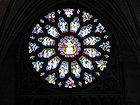
Rayonnant Gothic
The rose windows are divided by mullions radiating from a central roundel, overlapping in a complex design, each light terminating in a pointed arch and often interspersed with quatrefoils and other such shapes. Many of the largest rose windows in France are of this type, notably those at Paris and in the transepts of St Denis. A well-known example in England is that in the north transept of Westminster AbbeyWestminster Abbey
The Collegiate Church of St Peter at Westminster, popularly known as Westminster Abbey, is a large, mainly Gothic church, in the City of Westminster, London, United Kingdom, located just to the west of the Palace of Westminster. It is the traditional place of coronation and burial site for English,...
. This style occurs widely in Gothic churches and is also widely imitated in Gothic Revival buildings.
Flamboyant Gothic

Sainte-Chapelle
La Sainte-Chapelle is the only surviving building of the Capetian royal palace on the Île de la Cité in the heart of Paris, France. It was commissioned by King Louis IX of France to house his collection of Passion Relics, including the Crown of Thorns - one of the most important relics in medieval...
, Paris.
Some Late Gothic rose windows are of immense complexity of design, often using elements of the Gothic style in unexpected ways. A magnificent example is that of the façade of Amiens Cathedral
Amiens Cathedral
The Cathedral of Our Lady of Amiens , or simply Amiens Cathedral, is a Roman Catholic cathedral and seat of the Bishop of Amiens...
. Although the design usually radiates from a central point, it may not be symmetrical about each axis. This may be seen in the Flamboyant Decorated Gothic
Gothic architecture
Gothic architecture is a style of architecture that flourished during the high and late medieval period. It evolved from Romanesque architecture and was succeeded by Renaissance architecture....
window called the “Bishop’s Eye” at Lincoln Cathedral
Lincoln Cathedral
Lincoln Cathedral is a historic Anglican cathedral in Lincoln in England and seat of the Bishop of Lincoln in the Church of England. It was reputedly the tallest building in the world for 249 years . The central spire collapsed in 1549 and was not rebuilt...
in which the design takes the form of two ears of wheat.
Renaissance
The RenaissanceRenaissance architecture
Renaissance architecture is the architecture of the period between the early 15th and early 17th centuries in different regions of Europe, demonstrating a conscious revival and development of certain elements of ancient Greek and Roman thought and material culture. Stylistically, Renaissance...
made a break with the Gothic style, and a return to the Classical. Plain untraceried oculi were sometimes employed, either in Classical pediments or around domes as at the Pazzi Chapel
Pazzi Chapel
The Pazzi Chapel is a religious building in Florence, central Italy, considered to be one of the masterpieces of Renaissance architecture. It is located in the "first cloister" of the Basilica di Santa Croce.- History :...
, Florence.
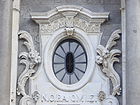
Baroque
The Baroque styleBaroque architecture
Baroque architecture is a term used to describe the building style of the Baroque era, begun in late sixteenth century Italy, that took the Roman vocabulary of Renaissance architecture and used it in a new rhetorical and theatrical fashion, often to express the triumph of the Catholic Church and...
saw much greater use of ocular windows, which were not always circular, but frequently oval or of a more complex shape. They were untraceried or crossed by mullions of very simple form but were often surrounded by ornate carving. The purpose of such windows was the subtle illumination of interior spaces, without resorting to large windows offering external visibility. They rarely form a dominant visual element to either the façade or the interior as do the great Gothic windows. However, there are some notable exceptions, in particular the glorious burst of light which pours through the oval alabaster window depicting the Holy Spirit
Holy Spirit
Holy Spirit is a term introduced in English translations of the Hebrew Bible, but understood differently in the main Abrahamic religions.While the general concept of a "Spirit" that permeates the cosmos has been used in various religions Holy Spirit is a term introduced in English translations of...
in the Reredos behind the High Altar of St. Peter’s Basilica, Rome.
Modern
Modern circular windows, which are most frequently of a simple ocular type, have an eclectic range of influences which includes Abstract artAbstract art
Abstract art uses a visual language of form, color and line to create a composition which may exist with a degree of independence from visual references in the world. Western art had been, from the Renaissance up to the middle of the 19th century, underpinned by the logic of perspective and an...
, ship's porthole
Porthole
A porthole is a generally circular, window used on the hull of ships to admit light and air. Porthole is actually an abbreviated term for "port hole window"...
s and the unglazed circular openings of Oriental architecture.
Symbolism

Christ
Christ is the English term for the Greek meaning "the anointed one". It is a translation of the Hebrew , usually transliterated into English as Messiah or Mashiach...
is shown seated in the centre "light" and within the lights around him are the symbols of the four Gospel writers, Apostles, Prophet
Prophet
In religion, a prophet, from the Greek word προφήτης profitis meaning "foreteller", is an individual who is claimed to have been contacted by the supernatural or the divine, and serves as an intermediary with humanity, delivering this newfound knowledge from the supernatural entity to other people...
s, Saints and Angels. Some windows show God's dominion over Heaven and Earth by including Zodiacal signs
Zodiac
In astronomy, the zodiac is a circle of twelve 30° divisions of celestial longitude which are centred upon the ecliptic: the apparent path of the Sun across the celestial sphere over the course of the year...
and Labours of the Months
Labours of the Months
The term Labours of the Months refers to cycles in Medieval and early Renaissance art depicting in twelve scenes the rural activities that commonly took place in the months of the year...
.
When rose windows are used in the transept ends, then one of those windows is frequently dedicated to Mary as the Mother of Jesus. In modern Catholic
Roman Catholic Church
The Catholic Church, also known as the Roman Catholic Church, is the world's largest Christian church, with over a billion members. Led by the Pope, it defines its mission as spreading the gospel of Jesus Christ, administering the sacraments and exercising charity...
thought, the rose window is often associated with the Virgin Mary because one of her titles, referred to by St Bernard of Clairvaux
Bernard of Clairvaux
Bernard of Clairvaux, O.Cist was a French abbot and the primary builder of the reforming Cistercian order.After the death of his mother, Bernard sought admission into the Cistercian order. Three years later, he was sent to found a new abbey at an isolated clearing in a glen known as the Val...
, is the “Mystical Rose
Our Lady of the Rosary
Our Lady of the Rosary is a title of the Blessed Virgin Mary in relation to the rosary....
”. However, the specific association of Mary with the rose window is unlikely during the Mediaeval period, because the term "rose window" was not coined until the 17th century, a time when few such windows were being constructed. However, in the 19th and 20th centuries, with the revival of the Gothic style much stained glass installed in rose windows, both in new churches and as restoration in old churches, was dedicated to the Virgin Mary.
Australia
A number of Australia’s cathedrals have Gothic Revival rose windows including three by William WardellWilliam Wardell
William Wilkinson Wardell was a Civil Engineer and Architect, notable not only for his work in Australia, the country to which he emigrated in 1858, but also for having a successful career as a surveyor, and an ecclesiastical architect in England and Scotland before his departure.In Australia,...
at St Mary's Cathedral, Sydney
St Mary's Cathedral, Sydney
The Metropolitan Cathedral of St Mary is the cathedral church of the Roman Catholic Archdiocese of Sydney and the seat of the Archbishop of Sydney, Cardinal George Pell. The cathedral is dedicated to "Mary, Help of Christians", Patron of Australia...
and another at St Patrick's Cathedral, Melbourne
St Patrick's Cathedral, Melbourne
St Patrick's Cathedral is the cathedral church of the Roman Catholic Archdiocese of Melbourne in Victoria, Australia, and seat of its archbishop, currently Denis J. Hart. The building is known internationally as a leading example of the Gothic Revival style of architecture.In 1974 Pope Paul VI...
which form the upper part of a very large seven-light window in the west end.
Ecuador
Two wonderful examples of rose windows are found in the National Basilica, built in 1893 and in the Santa Teresa Church, built in 1934. In CuencaCuenca, Ecuador
Cuenca is the capital of the Azuay Province. It is located in the highlands of Ecuador at about 2500 m above sea level...
in the southern Andes, the cathedral has a notable rose window.
England
In EnglandEngland
England is a country that is part of the United Kingdom. It shares land borders with Scotland to the north and Wales to the west; the Irish Sea is to the north west, the Celtic Sea to the south west, with the North Sea to the east and the English Channel to the south separating it from continental...
, the use of the rose window was commonly confined to the transepts although roses of great span were constructed in the west front of Byland Abbey
Byland Abbey
Byland Abbey is a ruined abbey and a small village in the Ryedale district of North Yorkshire, England at .-History:It was founded as a Savigniac abbey in January 1135 and was absorbed by the Cistercian order in 1147. It wasn't an easy start for the community who had had to move five times before...
and in the east front of Old St. Paul's Cathedral in London
London
London is the capital city of :England and the :United Kingdom, the largest metropolitan area in the United Kingdom, and the largest urban zone in the European Union by most measures. Located on the River Thames, London has been a major settlement for two millennia, its history going back to its...
.
Medieval rose windows occur at the cathedrals of York
York Minster
York Minster is a Gothic cathedral in York, England and is one of the largest of its kind in Northern Europe alongside Cologne Cathedral. The minster is the seat of the Archbishop of York, the second-highest office of the Church of England, and is the cathedral for the Diocese of York; it is run by...
, Lincoln
Lincoln Cathedral
Lincoln Cathedral is a historic Anglican cathedral in Lincoln in England and seat of the Bishop of Lincoln in the Church of England. It was reputedly the tallest building in the world for 249 years . The central spire collapsed in 1549 and was not rebuilt...
, Canterbury
Canterbury Cathedral
Canterbury Cathedral in Canterbury, Kent, is one of the oldest and most famous Christian structures in England and forms part of a World Heritage Site....
, Durham
Durham Cathedral
The Cathedral Church of Christ, Blessed Mary the Virgin and St Cuthbert of Durham is a cathedral in the city of Durham, England, the seat of the Anglican Bishop of Durham. The Bishopric dates from 995, with the present cathedral being founded in AD 1093...
and Oxford
Christ Church Cathedral, Oxford
Christ Church Cathedral is the cathedral of the diocese of Oxford, which consists of the counties of Oxfordshire, Buckinghamshire and Berkshire. It is also, uniquely, the chapel of Christ Church, a college of the University of Oxford.-History:...
.
Mediaeval Beverley Minster
Beverley Minster
Beverley Minster, in Beverley, East Riding of Yorkshire is a parish church in the Church of England. It is said to be the largest parish church in the UK....
has a fine example of an Early Gothic wheel window with ten spokes, each light terminating in a cusped trefoils and surrounded by decorative plate tracery.
Later windows are to be seen at the nondenominational Abney Park Chapel
Abney Park Chapel
Abney Park Chapel, is a Grade II Listed chapel, designed by William Hosking and built by John Jay that is situated in Europe's first wholly nondenominational cemetery, Abney Park Cemetery, London....
in London designed in 1838–40 by William Hosking FSA
William Hosking
William Hosking FSA was a writer, lecturer, and architect who had an important influence on the growth and development of London in Victorian times...
; Holy Trinity Church, Barnes, London; St Nicholas, Richmond; and St Albans Cathedral
St Albans Cathedral
St Albans Cathedral is a Church of England cathedral church at St Albans, England. At , its nave is the longest of any cathedral in England...
by George Gilbert Scott
George Gilbert Scott
Sir George Gilbert Scott was an English architect of the Victorian Age, chiefly associated with the design, building and renovation of churches, cathedrals and workhouses...
.
At Christ Church Appleton-le-Moors
Appleton-le-Moors
Appleton-le-Moors is a village and civil parish in the Ryedale district of North Yorkshire, England. According to the 2001 census it had a population of 183. The village is in the North York Moors National Park, and is near to Pickering and Kirkby Moorside....
, Yorkshire
Yorkshire
Yorkshire is a historic county of northern England and the largest in the United Kingdom. Because of its great size in comparison to other English counties, functions have been increasingly undertaken over time by its subdivisions, which have also been subject to periodic reform...
, the 19th-century architect J.L.Pearson
John Loughborough Pearson
John Loughborough Pearson was a Gothic Revival architect renowned for his work on churches and cathedrals. Pearson revived and practised largely the art of vaulting, and acquired in it a proficiency unrivalled in his generation.-Early life and education:Pearson was born in Brussels, Belgium on 5...
appears to have taken as his inspiration the regional floral symbol of the white rose
House of York
The House of York was a branch of the English royal House of Plantagenet, three members of which became English kings in the late 15th century. The House of York was descended in the paternal line from Edmund of Langley, 1st Duke of York, the fourth surviving son of Edward III, but also represented...
. This unusual plate-tracery window dating from the 1860s has been designed with five double sections like the two-part petals of a simple rose.
The largest rose window in England is believed to be that installed in the chapel of Lancing College
Lancing College
Lancing College is a co-educational English independent school in the British public school tradition, founded in 1848 by Nathaniel Woodard. Woodard's aim was to provide education "based on sound principle and sound knowledge, firmly grounded in the Christian faith." Lancing was the first of a...
in 1978, with a diameter of 32 feet.
France
FranceFrance
The French Republic , The French Republic , The French Republic , (commonly known as France , is a unitary semi-presidential republic in Western Europe with several overseas territories and islands located on other continents and in the Indian, Pacific, and Atlantic oceans. Metropolitan France...
has a great number of medieval rose windows, many containing ancient glass. In northern France, a rose window is usually the central feature of the facade. The transept facades commonly contain rose windows as well. Examples can be seen at Notre Dame, Paris (see left), the Basilica of Saint Denis (see left), Chartres Cathedral (see above), Reims Cathedral
Reims Cathedral
Notre-Dame de Reims is the Roman Catholic cathedral of Reims, where the kings of France were once crowned. It replaces an older church, destroyed by a fire in 1211, which was built on the site of the basilica where Clovis was baptized by Saint Remi, bishop of Reims, in AD 496. That original...
, Amiens Cathedral
Amiens Cathedral
The Cathedral of Our Lady of Amiens , or simply Amiens Cathedral, is a Roman Catholic cathedral and seat of the Bishop of Amiens...
and Strasbourg Cathedral
Strasbourg Cathedral
Strasbourg Cathedral or the Cathedral of Our Lady of Strasbourg is a Roman Catholic cathedral in Strasbourg, France. Although considerable parts of it are still in Romanesque architecture, it is widely consideredSusan Bernstein: , The Johns Hopkins University Press to be among the finest...
(see introductory pictures.)
Italy
In ItalyItaly
Italy , officially the Italian Republic languages]] under the European Charter for Regional or Minority Languages. In each of these, Italy's official name is as follows:;;;;;;;;), is a unitary parliamentary republic in South-Central Europe. To the north it borders France, Switzerland, Austria and...
, the rose window was particularly used by the Lombard
Lombardy
Lombardy is one of the 20 regions of Italy. The capital is Milan. One-sixth of Italy's population lives in Lombardy and about one fifth of Italy's GDP is produced in this region, making it the most populous and richest region in the country and one of the richest in the whole of Europe...
architect
Architect
An architect is a person trained in the planning, design and oversight of the construction of buildings. To practice architecture means to offer or render services in connection with the design and construction of a building, or group of buildings and the space within the site surrounding the...
s, as in San Zeno in Verona
Verona
Verona ; German Bern, Dietrichsbern or Welschbern) is a city in the Veneto, northern Italy, with approx. 265,000 inhabitants and one of the seven chef-lieus of the region. It is the second largest city municipality in the region and the third of North-Eastern Italy. The metropolitan area of Verona...
, and in the Cathedral of Modena
Modena
Modena is a city and comune on the south side of the Po Valley, in the Province of Modena in the Emilia-Romagna region of Italy....
, and in the Tuscan
Tuscany
Tuscany is a region in Italy. It has an area of about 23,000 square kilometres and a population of about 3.75 million inhabitants. The regional capital is Florence ....
Gothic churches like the Cathedrals of Siena
Siena
Siena is a city in Tuscany, Italy. It is the capital of the province of Siena.The historic centre of Siena has been declared by UNESCO a World Heritage Site. It is one of the nation's most visited tourist attractions, with over 163,000 international arrivals in 2008...
and Orvieto
Orvieto
Orvieto is a city and comune in Province of Terni, southwestern Umbria, Italy situated on the flat summit of a large butte of volcanic tuff...
.
An outstanding example of a rose window is the thirteen-spoked centrepiece of the Minor Basilica
Minor basilica
Minor basilica is a title given to some Roman Catholic churches. By canon law no Catholic church can be honoured with the title of basilica unless by apostolic grant or from immemorial custom....
in Larino
Larino
Larino is a town and comune of approximately 8,200 inhabitants in Molise, province of Campobasso, southern Italy. It is located in the fertile valley of the Biferno River....
, Molise
Molise
Molise is a region of Southern Italy, the second smallest of the regions. It was formerly part of the region of Abruzzi e Molise and now a separate entity...
(1312). Others are the Basilica of St Francis of Assisi
Basilica of San Francesco d'Assisi
The Papal Basilica of St. Francis of Assisi is the mother church of the Roman Catholic Order of Friars Minor—commonly known as the Franciscan Order—in Assisi, Italy, the city where St. Francis was born and died. The basilica is one of the most important places of Christian pilgrimage in Italy...
and Santa Maria di Collemaggio
Santa Maria di Collemaggio
S. Maria di Collemaggio is a large medieval church in L'Aquila, central Italy. It was the site of the original Papal Jubilee, a penitential observation devised by Pope Celestine V, who is buried here...
(1289) in L'Aquila
L'Aquila
L'Aquila is a city and comune in central Italy, both the capital city of the Abruzzo region and of the Province of L'Aquila. , it has a population of 73,150 inhabitants, but has a daily presence in the territory of 100,000 people for study, tertiary activities, jobs and tourism...
.
United States
A Baroque oculusOculus
An Oculus, circular window, or rain-hole is a feature of Classical architecture since the 16th century. They are often denoted by their French name, oeil de boeuf, or "bull's-eye". Such circular or oval windows express the presence of a mezzanine on a building's façade without competing for...
without tracery or stained glass can be seen at San Jose Mission
San Miguel de Aguayo, Texas
Mission San José y San Miguel de Aguayo is a historic Catholic mission in San Antonio, Texas, USA. The mission was named in part for the Marquis de San Miguel de Aguayo, José de Azlor y Virto de Vera...
in San Antonio, Texas
San Antonio, Texas
San Antonio is the seventh-largest city in the United States of America and the second-largest city within the state of Texas, with a population of 1.33 million. Located in the American Southwest and the south–central part of Texas, the city serves as the seat of Bexar County. In 2011,...
, which was founded by the Franciscan Fathers and dates from 1718–31.
The largest rose window in the United States is The Great Rose Window above the main doors of the Cathedral of St. John the Divine in New York City
New York City
New York is the most populous city in the United States and the center of the New York Metropolitan Area, one of the most populous metropolitan areas in the world. New York exerts a significant impact upon global commerce, finance, media, art, fashion, research, technology, education, and...
. It is designed in the Gothic Revival style and made from more than 10,000 pieces of stained glass
Stained glass
The term stained glass can refer to coloured glass as a material or to works produced from it. Throughout its thousand-year history, the term has been applied almost exclusively to the windows of churches and other significant buildings...
.
Washington National Cathedral
Washington National Cathedral
The Washington National Cathedral, officially named the Cathedral Church of Saint Peter and Saint Paul, is a cathedral of the Episcopal Church located in Washington, D.C., the capital of the United States. Of neogothic design, it is the sixth-largest cathedral in the world, the second-largest in...
has three large rose windows which represent the Creation, Last Judgement, and Glory of God.
In 1954, the French
France
The French Republic , The French Republic , The French Republic , (commonly known as France , is a unitary semi-presidential republic in Western Europe with several overseas territories and islands located on other continents and in the Indian, Pacific, and Atlantic oceans. Metropolitan France...
artist Henri Matisse
Henri Matisse
Henri Matisse was a French artist, known for his use of colour and his fluid and original draughtsmanship. He was a draughtsman, printmaker, and sculptor, but is known primarily as a painter...
created the Abby Aldrich Rockefeller
Abby Aldrich Rockefeller
Abby Aldrich Rockefeller, , was a prominent socialite and philanthropist and the second-generation matriarch of the renowned Rockefeller family...
Memorial Rose Window on the east wall of the Union Church of Pocantico Hills, New York
New York
New York is a state in the Northeastern region of the United States. It is the nation's third most populous state. New York is bordered by New Jersey and Pennsylvania to the south, and by Connecticut, Massachusetts and Vermont to the east...
.
See also
- MandalaMandalaMaṇḍala is a Sanskrit word that means "circle". In the Buddhist and Hindu religious traditions their sacred art often takes a mandala form. The basic form of most Hindu and Buddhist mandalas is a square with four gates containing a circle with a center point...
- KaleidoscopeKaleidoscopeA kaleidoscope is a circle of mirrors containing loose, colored objects such as beads or pebbles and bits of glass. As the viewer looks into one end, light entering the other end creates a colorful pattern, due to the reflection off the mirrors...
- Stained GlassStained glassThe term stained glass can refer to coloured glass as a material or to works produced from it. Throughout its thousand-year history, the term has been applied almost exclusively to the windows of churches and other significant buildings...
External links
- therosewindow.com Painton Cowen's website, with many good images of rose windows
- Tips & Tricks to Gothic Geometry How to design a rose window
- Chartres Rose Window Geometry
- Wagon Wheel Rose Windows of the Medieval Norman Cathedrals of Puglia - Photos

